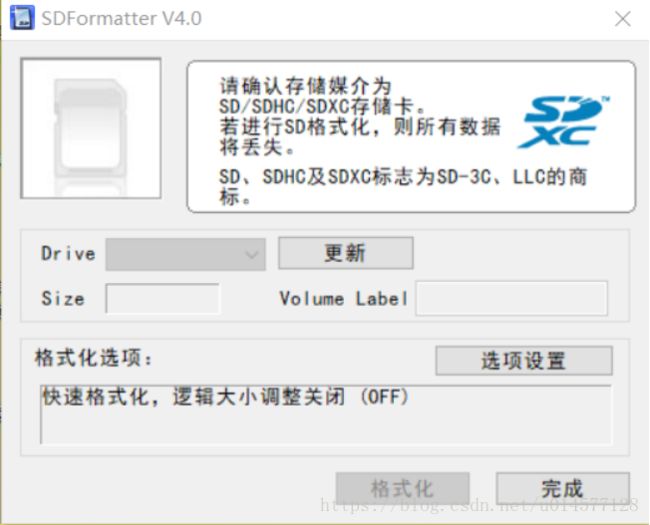树莓派安装opencv(包括编译扩展模块)
树莓派安装opencv
一:安装系统
1. 利用工具SDFormatter将内存卡格式化
选项设置选择擦除格式化,然后点击格式化
2. 烧写系统
准备后缀为img的文件
将这个zip文件解压得到img的镜像文件
使用软件
将img文件写入sd卡
点击Write将文件写入,大概需要5分钟
3. 将烧写好的sd卡直接插入树莓派板子,上电运行,第一次运行不需要密码,但要连接屏幕,因为第一次运行没有开启ssh服务,无法使用远程登陆
4. 默认用户和密码
用户:pi 密码:raspberry
修改密码 passwd
启动root用户
5. 修改配置文件,允许root用户远程登陆(这样可以免去以后频繁移动文件权限不够的问题)
安装vim 输入:apt-get install vim
输入vim /etc/ssh/sshd_config
开启ssh服务
输入 service ssh start
Chkconfig ssh on #设置自启
二.Opencv的安装
网址https://github.com/Tes3awy/OpenCV-3.2.0-Compiling-on-Raspberry-Pi
Compile OpenCV 3.2.0 + OpenCV Contrib for Python on Raspberry Pi
I assume you have downloaded Raspbian and installed it on your Pi. Also I assume your RPi is running and functioning perfectly.
Make sure you have extended your disk before performing any step from below.
Step 1:
$ sudo apt-get update
$ sudo apt-get upgrade
$ sudo rpi-update (can be skipped, but recommended) (don't do it if you will use the RPI cam as recommended by official RPI Website)
$ sudo reboot now
Step 2:
$ sudo apt-get install build-essential cmake pkg-config
Step 3:
$ sudo apt-get install libjpeg-dev libtiff5-dev libjasper-dev libpng12-dev
Step 4:
$ sudo apt-get install libgtk2.0-dev libgstreamer0.10-0-dbg libgstreamer0.10-0 libgstreamer0.10-dev libv4l-0 libv4l-dev
Step 5:
$ sudo apt-get install libavcodec-dev libavformat-dev libswscale-dev libv4l-dev
$ sudo apt-get install libxvidcore-dev libx264-dev
Step 6:
$ sudo apt-get install libatlas-base-dev gfortran
$ sudo apt-get install python-numpy python-scipy python-matplotlib
$ sudo apt-get install default-jdk ant
$ sudo apt-get install libgtkglext1-dev
$ sudo apt-get install v4l-utils
Step 7:
install pip
$ wget https://bootstrap.pypa.io/get-pip.py
$ sudo python get-pip.py
Step 8:
$ sudo apt-get install python2.7-dev
Step 9:
$ sudo pip install numpy
Step 10:
Download OpenCV 3.2.0 and unpack it
$ cd ~
$ wget -O opencv.zip https://github.com/Itseez/opencv/archive/3.2.0.zip
$ unzip opencv.zip
Contrib Libraries (Non-free Modules)
$ wget -O opencv_contrib.zip https://github.com/Itseez/opencv_contrib/archive/3.2.0.zip
$ unzip opencv_contrib.zip
Step 11:
preparing the build
$ cd ~/opencv-3.2.0/
$ mkdir build
$ cd build
$ cmake -D CMAKE_BUILD_TYPE=RELEASE \
-D CMAKE_INSTALL_PREFIX=/usr/local \
-D INSTALL_C_EXAMPLES=OFF \
-D INSTALL_PYTHON_EXAMPLES=ON \
-D OPENCV_EXTRA_MODULES_PATH=~/opencv_contrib-3.2.0/modules \
-D BUILD_EXAMPLES=ON \
-D ENABLE_NEON=ON ..
Step 12:
takes about 3.5 to 4 hours
$ sudo make -j3 (I prefer -j3, because it doesn't use all the cores so it keeps the RasPi cool enough)
# If any errors occurs and the process fails to continue, execute
$ sudo make clean
# Sometimes using multicores can cause problems, so if you face any problems just execute $ sudo make , but keep in mind that it will take much longer so be patient as much as you can and grab your cup of tea.
Step 13:
installing the build prepared in step 11
$ sudo make install
$ sudo ldconfig
Step 14:
$ sudo nano /etc/ld.so.conf.d/opencv.conf
opencv.conf will be blank, add the following line, then save and exit nano:
/usr/local/lib # enter this in opencv.conf, NOT at the command line
(leave a blank line at the end of opencv.conf)
save opencv.conf by pressing ctrl+o get back again to the command line by pressing ctrl+x
$ sudo ldconfig
$ sudo nano /etc/bash.bashrc
add the following lines at the bottom of bash.bashrc
PKG_CONFIG_PATH=$PKG_CONFIG_PATH:/usr/local/lib/pkgconfig
export PKG_CONFIG_PATH
(leave a blank line at the end of bash.bashrc) save bash.bashrc changes (ctrl+o), then back at the command line (ctrl+x),
#Step 15: Reboot
$ sudo shutdown -r now
#Step 16 Last Step: verifying the installation
Open Python 2 IDLE on RasPi Type the following lines in the python shell:
>>> import cv2
>>> print cv2.__version__
the following line should appear then:
'3.2.0'
Done
TODO
· Connect to RPi without internet connection.
资料下载地址网盘链接 链接:https://pan.baidu.com/s/1QJePM_wGY8-KYvcdR-0ePA 密码:lt68


里面包含opencv的源码及扩展模块,以及详细安装方法的word文档




